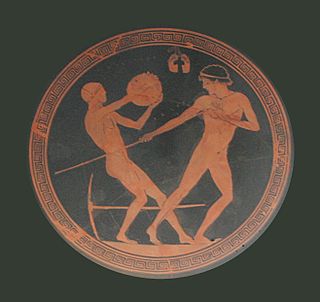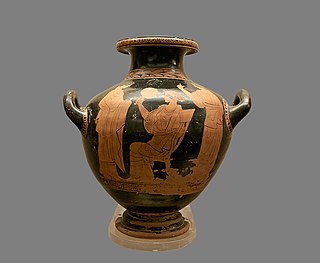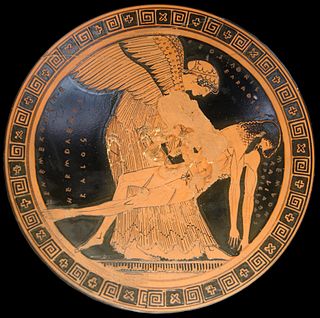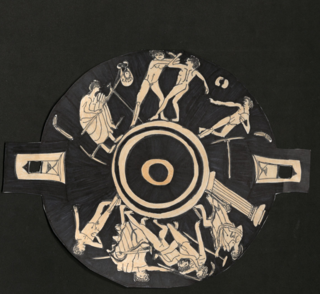
A pentathlon is a contest featuring five events. The name is derived from Greek: combining the words pente (five) and -athlon (competition). The first pentathlon was documented in Ancient Greece and was part of the Ancient Olympic Games. Five events were contested over one day for the Ancient Olympic pentathlon, starting with the long jump, javelin throwing, and discus throwing, followed by the stadion and wrestling. Pentathletes were considered to be among the most skilled athletes, and their training was often part of military service—each of the five events in the pentathlon was thought to be useful in war or battle.

In the pottery of ancient Greece, a kylix is the most common type of cup in the period, usually associated with the drinking of wine. The cup often consists of a rounded base and a thin stem under a basin. The cup is accompanied by two handles on opposite sides.

Black-figure pottery painting is one of the styles of painting on antique Greek vases. It was especially common between the 7th and 5th centuries BCE, although there are specimens dating in the 2nd century BCE. Stylistically it can be distinguished from the preceding orientalizing period and the subsequent red-figure pottery style.

Exekias was an ancient Greek vase painter and potter who was active in Athens between roughly 545 BC and 530 BC. Exekias worked mainly in the black-figure technique, which involved the painting of scenes using a clay slip that fired to black, with details created through incision. Exekias is regarded by art historians as an artistic visionary whose masterful use of incision and psychologically sensitive compositions mark him as one of the greatest of all Attic vase painters. The Andokides painter and the Lysippides Painter are thought to have been students of Exekias.

An aryballos was a small spherical or globular flask with a narrow neck used in Ancient Greece. It was used to contain perfume or oil, and is often depicted in vase paintings being used by athletes during bathing. In these depictions, the vessel is at times attached by a strap to the athlete's wrist, or hung by a strap from a peg on the wall.

Halteres were a type of dumbbells used in ancient Greece. In ancient Greek sports, halteres were used as lifting weights, and also as weights in their version of the long jump. Halteres were held in both hands to allow an athlete to jump a greater distance; they may have been dropped after the first or second jump.

The hydria is a form of Greek pottery from between the late Geometric period and the Hellenistic period. The etymology of the word hydria was first noted when it was stamped on a hydria itself, its direct translation meaning 'jug'.
Oltos was a Late Archaic Greek vase painter, active in Athens from 525 BC to 500 BC. About 150 works by him are known. Two pieces, a cup in Berlin and a cup in Tarquinia, are signed by him as painter.

Douris or Duris was an ancient Athenian red-figure vase-painter and potter active c. 500 to 460 BCE.

The Brygos Painter was an ancient Greek Attic red-figure vase painter of the Late Archaic period. Together with Onesimos, Douris and Makron, he is among the most important cup painters of his time. He was active in the first third of the 5th century BCE, especially in the 480s and 470s BCE. He was a prolific artist to whom over two hundred vases have been attributed, but he is perhaps best known for the Brygos Cup, a red-figure kylix in the Louvre which depicts the "iliupersis" or sack of Troy.

The pottery of ancient Greece has a long history and the form of Greek vase shapes has had a continuous evolution from Minoan pottery down to the Hellenistic period. As Gisela Richter puts it, the forms of these vases find their "happiest expression" in the 5th and 6th centuries BC, yet it has been possible to date vases thanks to the variation in a form’s shape over time, a fact particularly useful when dating unpainted or plain black-gloss ware.

A kalos inscription is a form of epigraph found on Attic vases and graffiti in antiquity, mainly during the Classical period from 550 to 450 BC. The word kalos (καλός), meaning 'handsome' or 'beautiful', was often accompanied by the name of a certain man, or sometimes simply by the word pais (παῖς), meaning the 'boy' or 'youth', without naming a particular person. The female version was kalē (καλή). The kalos inscriptions typically had an erotic connotation.

The Berlin Foundry Cup is a red-figure kylix from the early 5th century BC. It is the name vase of the Attic vase painter known conventionally as the Foundry Painter. Its most striking feature is the exterior depiction of activities in an Athenian bronze workshop or foundry. It is an important source on ancient Greek metal-working technology.

The Ancient Olympic pentathlon was an athletic contest at the Ancient Olympic Games, and other Panhellenic Games of Ancient Greece. The name derives from Greek, combining the words pente (five) and athlon (competition). Five events were contested over one day, starting with the stadion, followed by the javelin throw, discus throw and long jump, and ending with wrestling. While pentathletes were considered to be inferior to the specialized athletes in a certain event, they were superior in overall development and were some of the most well balanced of all the athletes. Their training was often part of military service—each of the five events was thought to be useful in battle.

The Brygos Cup of Würzburg is an Attic red-figure kylix from about 480 BC. It was made by the Brygos potter and painted by the man known as the Brygos Painter. It depicts some of the best-known images of ancient Greek pottery.

The Dionysus Cup is the modern name for one of the best known works of ancient Greek vase painting, a kylix dating to 540–530 BC. It is one of the masterpieces of the Attic black-figure potter Exekias and one of the most significant works in the Staatliche Antikensammlungen in Munich.
The Crouching Satyr Eye-Cup is a ceramic vessel located in gallery 215B in the Museum of Fine Arts in Boston, Massachusetts, is an ancient Greek kylix dating to the Archaic Period. The cup, which was used within Ancient Greek symposiums as a form of entertainment amongst drunken revelers, was bought in London from an old collection, and eventually purchased by the MFA from Edward Perry Warren in March 1903.

Athletics were an important part of the cultural life of Ancient Greeks. Depictions of boxing and bull-leaping can be found back to the Bronze Age. Buildings were created for the sole use of athletics including stadia, palaestrae, and gymnasiums. Starting in the Archaic period, Panhellenic Games, including the Olympic Games, begin taking place each year. These games gave people from all over Greece the chance to gain fame for their athletic prowess. Athletics in Greece became one of the most commonly depicted scenes of everyday life in their art.

The kylix depicting athletic combats is a ceramic drinking cup made approximately in the late Archaic period, 490 B.C., in Attica. It is currently in the Museum of Fine Arts Boston as part of The Ancient World Collections. The artist, Onesimos, used red-figure technique for the decoration, which was invented in Athens around 530 B.C. and quickly became one of the leading modes of decoration Athenian potters used. Red-figure technique was favored because it allowed for a greater representation of garments, emotions and anatomy making it useful for artists, such as Onesimos, to use in painting athletic events.

Physical training has been present in some human societies throughout history. Usually, people trained to prepare for physical competition or display, to improve physical, emotional and mental health, and to look attractive. The activity took a variety of different forms but quick dynamic exercises were favoured over slow or more static ones. For example, running, jumping, wrestling, gymnastics and throwing heavy stones are mentioned frequently in historical sources and emphasised as being highly effective training-methods. Notably, they are also forms of exercise which are readily achievable for most people to some extent or another.


















